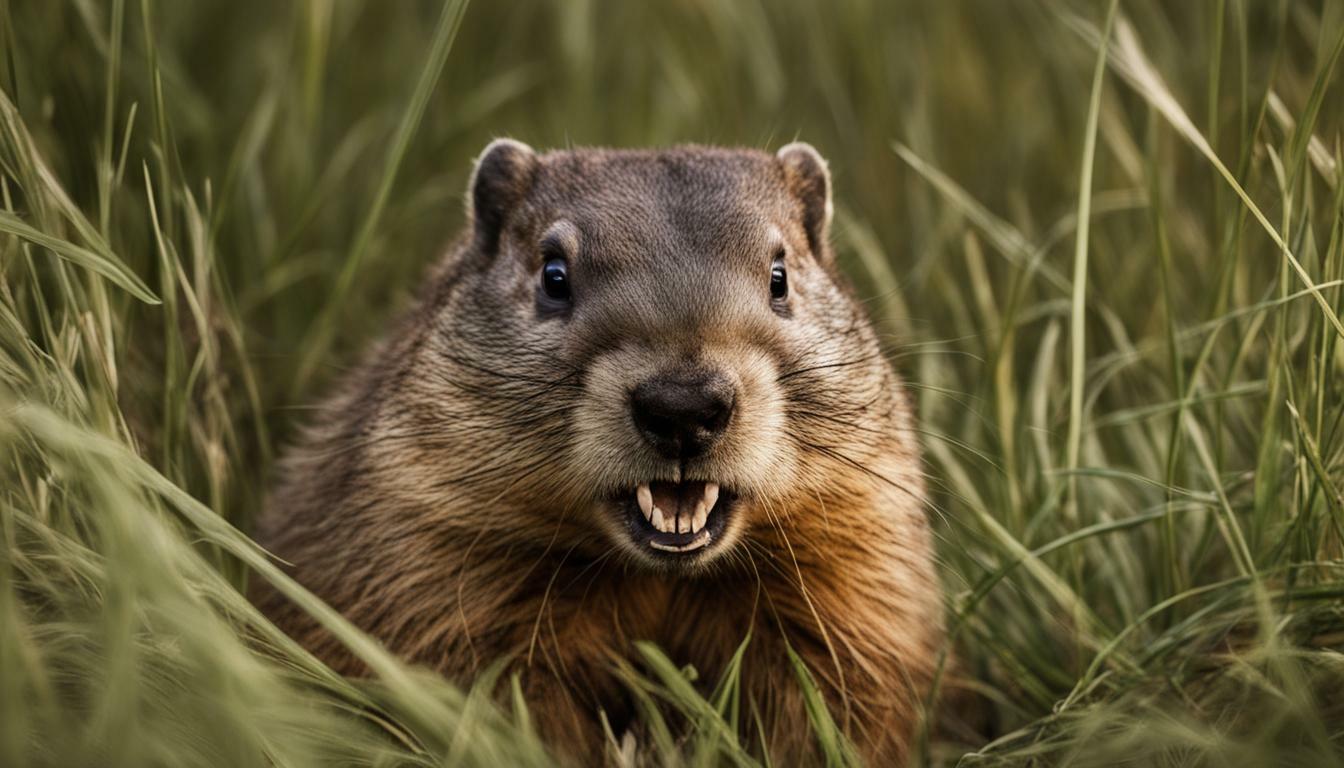Groundhogs, also known as woodchucks, have a unique dental structure that includes a specific number of teeth. These rodents have four incisors, two upper and two lower, which continue to grow at a rate of 1/16 of an inch every week. To keep their teeth in check, groundhogs constantly gnaw on leaves, grass, trees, and roots. In addition to the incisors, they have a total of 18 chewing teeth. Their white teeth, along with their large incisors and claws, play a role in defending themselves from predators.
Key Takeaways:
- Groundhogs have four incisors, which continue to grow throughout their lives.
- Their incisors grow at a rate of 1/16 of an inch per week.
- Groundhogs have a total of 18 chewing teeth.
- Constant gnawing is necessary for groundhogs to maintain their dental health.
- Their white teeth and large incisors contribute to their defense mechanism against predators.
Groundhog Dental Anatomy
Groundhogs possess different types of teeth that serve various purposes in their daily lives. Understanding their dental anatomy can provide insights into their oral health and overall well-being.
At the front of a groundhog’s mouth, you will find their incisors – four in total, two upper and two lower. These incisors are constantly growing at a rate of 1/16 of an inch every week. To keep their teeth in check, groundhogs gnaw on leaves, grass, trees, and roots. Their incisors play a crucial role in gnawing, allowing them to break down vegetation and build their burrows.
Beyond the incisors, groundhogs have a set of chewing teeth known as molars. They have a total of 18 molars, including the four incisors. These molars are responsible for grinding and crushing food, enabling groundhogs to digest a variety of plant materials. Proper dental care is vital for groundhogs to maintain their molars’ functionality and ensure healthy eating habits.
Groundhog Dental Anatomy
| Type of Tooth | Function |
|---|---|
| Incisors | Gnawing and breaking down vegetation |
| Molars | Grinding and crushing food |
Groundhog teeth are white in color, reflecting their natural enamel composition. This coloration is normal and does not indicate any dental issues. In fact, their teeth’s bright appearance helps to enhance their overall charm.
Aside from their functionality, groundhog teeth also serve as a defense mechanism. Groundhogs possess large incisors and claws that they can use to protect themselves from predators. These sharp teeth and strong claws act as formidable tools in warding off potential threats.
Understanding the dental anatomy of groundhogs provides valuable insights into their oral health. By maintaining proper dental care through natural wear and constant gnawing, groundhogs can ensure healthy teeth and a well-functioning digestive system.
Groundhog Incisors: The Front Teeth
Groundhogs have notable front teeth called incisors that play a vital role in their feeding habits. These incisors are located in the upper and lower jaw, with a total of four. They are responsible for cutting and gnawing through vegetation, such as leaves, grass, trees, and roots, which form a significant part of the groundhog’s diet.
The incisors of groundhogs continue to grow throughout their lives at a rate of 1/16 of an inch every week. This constant growth is necessary to compensate for the natural wear caused by their gnawing activities. By continuously chewing on fibrous materials, groundhogs maintain the proper length of their incisors, preventing them from becoming overgrown.
Groundhogs’ incisors are large, strong, and slightly curved, enabling them to efficiently cut and grind vegetation. They are white in color, which is characteristic of most rodent teeth. In addition to their prominent incisors, groundhogs also possess 14 molars located at the back of their mouth. These molars are responsible for grinding and chewing the food that has been processed by the incisors, aiding in digestion.
| Number of Incisors | Number of Molars |
|---|---|
| 4 | 14 |
Groundhogs use their large incisors not only for feeding but also as a form of defense. When threatened by predators, they can quickly bite and deliver a painful nip. Along with their sharp claws, groundhogs employ their teeth as a defense mechanism, deterring potential threats and ensuring their safety.
Groundhog Molars: The Chewing Teeth
Groundhogs possess molars that aid in their chewing process, enabling them to consume a wide range of vegetation. These molars, located at the back of their mouths, serve an important role in breaking down tough plant matter into smaller, more manageable pieces.
With a total of 18 chewing teeth, groundhogs can efficiently grind and crush their food. These teeth include premolars and molars, which are specifically designed for the task of mastication. Their strong molars allow them to process a diverse array of plants, including grasses, leaves, and even the bark of trees.
To maintain their dental health, groundhogs need to continuously gnaw on objects. This gnawing behavior not only helps to wear down their constantly growing incisors but also stimulates blood flow in their gums, promoting overall oral health. Without regular gnawing, their teeth could overgrow, leading to discomfort, difficulty in eating, and potential dental issues.
| Type of Tooth | Function |
|---|---|
| Incisors | Gnawing and cutting through vegetation |
| Premolars | Additional grinding and breaking down of food |
| Molars | Main chewing teeth responsible for thorough food processing |
Groundhogs’ dental care is crucial for their overall well-being. Regular gnawing and a balanced diet help maintain the proper wear and health of their teeth. Additionally, they rely on their strong incisors and claws as a defense mechanism against predators. These sharp front teeth, paired with their powerful jaws, allow them to ward off threats and protect themselves when necessary.
Growth of Groundhog Teeth
Groundhog teeth have a unique characteristic of continuous growth, requiring regular gnawing to prevent overgrowth. These rodents have four incisors, two in the upper jaw and two in the lower jaw. These incisors grow at a rate of 1/16 of an inch every week, which is quite remarkable. To keep their teeth in check, groundhogs constantly gnaw on various vegetation such as leaves, grass, trees, and roots.
With a total of 18 chewing teeth, including the four incisors, groundhogs have a robust dental structure. Their molars play a crucial role in grinding and chewing the tough plant material they consume. This continuous growth ensures that their teeth are always sharp and effective in their feeding habits.
To put it into perspective, if groundhogs did not gnaw regularly, their teeth would become too long and hinder their ability to feed properly, resulting in malnutrition and other serious health issues. So, the constant gnawing behavior is not only a means of maintaining dental health but also a necessary survival mechanism for these fascinating creatures.
| Type of Teeth | Number in Groundhogs |
|---|---|
| Incisors | 4 (2 upper, 2 lower) |
| Molars | 14 (7 upper, 7 lower) |
Groundhogs take great care of their dental health by continuously gnawing on a variety of materials. This behavior not only helps them keep their teeth properly trimmed but also contributes to their overall well-being. Their white teeth, along with their large incisors and sharp claws, serve as effective defense mechanisms against potential predators.
So, the next time you spot a groundhog in the wild or even in your backyard, take a moment to appreciate their remarkable dental structure and the importance of their teeth in their daily lives.
Groundhog Teeth Color
Groundhog teeth are typically white in color, reflecting their overall oral health. The natural coloration of their teeth is a result of the enamel that covers the surface. Enamel is the outermost layer of the teeth and acts as a protective barrier against damage and decay. It is composed of minerals, mainly calcium, and gives the teeth their characteristic white appearance.
Unlike humans, groundhogs do not have the same level of exposure to staining substances, such as coffee or tobacco, which can discolor teeth. Additionally, groundhogs have a diet primarily consisting of plant materials, which does not typically lead to tooth discoloration. As a result, their teeth maintain their white coloration throughout their lives.
The bright white color of groundhog teeth is also an indicator of their overall oral health. It suggests that their teeth are strong and free of any significant decay or damage. Groundhogs’ continuous gnawing activities help to keep their teeth clean and prevent the buildup of plaque and tartar, further contributing to their white appearance.
| Key Points |
|---|
| Groundhog teeth are white due to the enamel covering them |
| Their diet and lack of exposure to staining substances contribute to the maintenance of their white color |
| The white color of their teeth indicates good overall oral health |
Groundhog Teeth as a Defense Mechanism
Groundhogs possess powerful teeth and claws that serve as a defense mechanism against potential threats. Their large incisors and sharp claws help them protect themselves from predators and other dangers in their environment. When faced with danger, groundhogs can use their teeth and claws to fight back or escape to safety.
Their front teeth, known as incisors, are particularly effective weapons. They are sturdy and sharp, enabling groundhogs to bite and tear through tough materials, such as bark, branches, and even the occasional metal fencing. These incisors continue to grow throughout their lives, at a rate of 1/16 of an inch every week. By constantly gnawing on various objects, groundhogs keep their incisors at an optimal length, ensuring they remain effective for defense.
In addition to their teeth, groundhogs also rely on their claws for defense. These strong claws allow them to dig burrows and create intricate tunnel systems where they can seek refuge from predators. They can quickly retreat into their burrows when they feel threatened, using their claws to dig deep into the ground and create secure hiding places.
| Groundhog Teeth and Claws | Groundhog Dental Anatomy |
|---|---|
| Powerful incisors | Front teeth used for biting and tearing |
| Continuously growing | Gnawing behavior helps maintain optimal length |
| Sharp claws | Aid in digging burrows and escaping predators |
Overall, groundhog teeth and claws play a crucial role in their survival. These natural weapons allow them to defend themselves against potential threats and maintain their safety in their habitat. It is fascinating to see how these powerful dental structures contribute to the resilience and adaptability of these remarkable animals.
Groundhog Dental Care
Proper dental care is crucial for groundhogs to ensure their overall oral health. Just like humans, these furry creatures need to take care of their teeth to prevent dental issues and maintain their ability to eat and defend themselves. Groundhogs have a total of 18 chewing teeth, which include four powerful incisors. These incisors continue to grow at a rate of 1/16 of an inch every week.
To keep their teeth in check, groundhogs constantly gnaw on various materials such as leaves, grass, trees, and roots. This gnawing action not only helps control the growth of their teeth but also helps to wear them down and prevent overgrowth. It also sharpened their incisors, making them effective tools for digging burrows and defending themselves from predators.
Table:
| Type of Teeth | Function | Number |
|---|---|---|
| Incisors | Gnawing, digging, defense | 4 |
| Molars | Chewing and grinding | 14 |
In addition to gnawing, groundhogs also use their claws to dig burrows, which serve as their homes and provide protection from predators. The combination of their large incisors and sharp claws makes them formidable opponents when it comes to defending themselves.
While groundhogs have natural mechanisms to maintain their dental health, it is still important for humans to be aware of their oral care needs. Providing a suitable habitat with a variety of gnawing materials can help keep groundhog teeth healthy. This includes offering branches, logs, and chew toys to satisfy their natural gnawing instincts. By ensuring proper dental care, we can help these adorable creatures live healthier and happier lives.
The Importance of Groundhog Teeth
Groundhog teeth play a vital role in their survival, enabling them to fulfill their dietary requirements. These small mammals, also known as woodchucks, have a total of 18 chewing teeth, including four incisors. These incisors, two upper and two lower, continue to grow at a rate of 1/16 of an inch every week.
To keep their teeth in check, groundhogs constantly gnaw on leaves, grass, trees, and roots. This gnawing action not only helps them maintain the appropriate length of their teeth but also assists in breaking down their food. With their strong incisors and sharp claws, groundhogs can effectively defend themselves from predators by using their teeth as a natural weapon.
In addition to their defensive capabilities, groundhog teeth serve a crucial role in their feeding habits. Their front incisors aid in gnawing through hard vegetation, while their molars, located towards the back of the mouth, are responsible for grinding and chewing their food. Without their teeth, groundhogs would struggle to consume their necessary diet of grasses, leaves, and other plant materials.
| Type of Teeth | Function |
|---|---|
| Incisors | Gnawing and defending against predators |
| Molars | Grinding and chewing food |
Overall, groundhog teeth are an essential aspect of their oral health and well-being. Their continuous growth and proper maintenance through gnawing ensure that these animals can thrive in their natural habitat. So, the next time you spot a groundhog, take a moment to appreciate the importance of their teeth in their daily life and survival.
Interesting Facts About Groundhog Teeth
Discover some fascinating facts about groundhog teeth that you may not have known before. These unique dental features play a crucial role in the lives of these furry creatures.
Did you know?
- Groundhogs, also known as woodchucks, have four incisors, two upper and two lower, which continue to grow at a rate of 1/16 of an inch every week.
- Constant gnawing is necessary for groundhogs to keep their teeth in check. They rely on leaves, grass, trees, and roots to wear down their incisors and prevent them from overgrowing.
- Groundhogs have a total of 18 chewing teeth, including the four incisors. These molars help them effectively process their plant-based diet, which mainly consists of vegetation.
Intriguing characteristics
Groundhogs exhibit some intriguing characteristics when it comes to their teeth:
- Their teeth are naturally white, an indicator of good oral health. This brightness is maintained through their constant gnawing habits.
- Groundhogs use their large incisors, as well as their sharp claws, as a defense mechanism against predators. Their teeth and claws aid in protecting them from potential threats.
Now that you’ve learned some intriguing facts about groundhog teeth, you can appreciate the importance of these dental structures in their daily lives. From their continuous growth to their role in defense and feeding habits, groundhog teeth are truly fascinating!
| Groundhog Teeth Facts | |
|---|---|
| Number of incisors | 4 |
| Rate of incisor growth | 1/16 of an inch every week |
| Number of chewing teeth (including incisors) | 18 |
| Role in defense | Used with sharp claws as a defense mechanism against predators |
| Teeth color | Naturally white, maintained through constant gnawing |
Conclusion
Groundhog teeth are not only fascinating but also essential for the survival and well-being of these remarkable creatures. With four incisors, two upper and two lower, groundhogs rely on their teeth to fulfill a variety of important functions. Their incisors continue to grow at a rate of 1/16 of an inch every week, requiring constant gnawing to keep them in check.
These diligent chewers use their teeth to gnaw on leaves, grass, trees, and roots, which not only helps maintain the proper length of their incisors but also provides necessary nutrition. In addition to their incisors, groundhogs possess a total of 18 chewing teeth that assist in grinding their food into smaller, more digestible pieces.
Groundhog teeth are distinctive in their appearance, as they are naturally white in color. Their pearly hue is a testament to their good oral health and the cleanliness of their dental structures. The groundhog’s large incisors, accompanied by sharp claws, also serve as a means of defense against potential predators, allowing these creatures to protect themselves when necessary.
To ensure their continued well-being, groundhogs must prioritize dental care. Maintaining proper oral hygiene is crucial for their overall health, as neglecting it can lead to potential complications. Groundhogs’ teeth play a vital role in their feeding habits and survival, making regular dental care an essential aspect of their lives.
FAQ
How many teeth does a groundhog have?
Groundhogs have a total of 18 chewing teeth, including four incisors.
What are the different types of teeth in a groundhog’s mouth?
Groundhogs have four incisors, two upper and two lower, along with molars for chewing.
How do groundhogs maintain their dental health?
Groundhogs constantly gnaw on leaves, grass, trees, and roots, which helps keep their teeth in check.
What color are groundhog teeth?
Groundhog teeth appear white in color.
How do groundhogs defend themselves using their teeth?
Groundhogs use their large incisors and claws as a defense mechanism against predators.
Why is dental care important for groundhogs?
Proper dental care is essential for the overall oral health and well-being of groundhogs.
How do groundhog teeth contribute to their feeding habits?
Groundhog teeth play a crucial role in the process of chewing and digesting their food.
What are some interesting facts about groundhog teeth?
Groundhogs’ teeth grow continuously at a rate of 1/16 of an inch every week.




